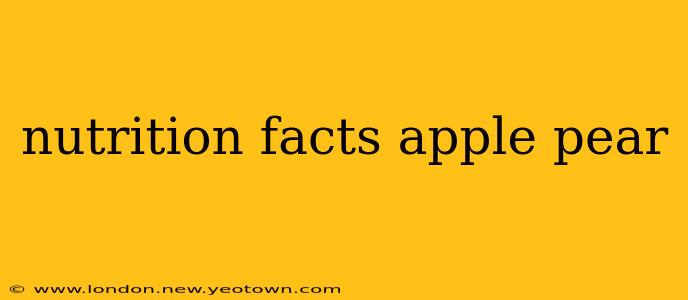Apples and pears. These two fruits grace our fruit bowls, our lunchboxes, and our desserts, often vying for a spot as our favorite. But beyond their pleasing textures and sweet-tart flavors, how do these popular fruits stack up nutritionally? Let's dive into a delicious comparison, exploring the nutritional differences and similarities between apples and pears.
What are the nutritional differences between apples and pears?
This is a question many ask when comparing these two fruits. The truth is, apples and pears are both nutritional powerhouses, offering a good dose of vitamins, minerals, and fiber. However, there are some subtle but significant differences. Generally, pears tend to be slightly higher in fiber and certain vitamins, while apples boast a slightly higher vitamin C content. Let's look at the specifics:
Apples are a good source of vitamin C, offering a boost to your immune system. They also contain antioxidants like quercetin, which are linked to various health benefits, including reducing inflammation. The fiber content in apples contributes to digestive health and helps regulate blood sugar levels.
Pears, on the other hand, often contain more fiber, particularly soluble fiber, which aids in lowering cholesterol and promoting a healthy gut. They also provide a good amount of vitamin K, essential for blood clotting and bone health. Pears also contain a decent amount of potassium, vital for maintaining healthy blood pressure.
Are pears healthier than apples?
There's no single winner in the "healthier" contest between apples and pears. Both fruits offer a remarkable array of nutrients. The "better" choice depends largely on individual dietary needs and preferences. Someone looking to boost their fiber intake might lean towards pears, while someone needing a vitamin C boost might opt for an apple. The best approach is to include both in a balanced diet for maximum nutritional benefit.
How many calories are in an apple and a pear?
Calorie counts vary depending on the size and type of apple or pear. Generally, a medium-sized apple (about 3 inches in diameter) contains around 95 calories, while a medium-sized pear (about 3 inches long) boasts approximately 100 calories. These calorie counts make both fruits excellent low-calorie snack options.
Which fruit has more fiber: apple or pear?
Pears generally have a slight edge in fiber content compared to apples. The specific amount varies depending on the variety and size of the fruit, but pears typically offer a higher amount of both soluble and insoluble fiber.
Which fruit is better for weight loss: apple or pear?
Both apples and pears can be part of a healthy weight loss diet due to their low calorie count, high fiber content, and ability to promote satiety. Their fiber content helps you feel fuller for longer, preventing overeating. The choice between the two is largely a matter of personal preference.
What are the benefits of eating apples and pears?
The benefits of incorporating apples and pears into your diet are numerous:
- Improved Digestion: The fiber in both fruits promotes healthy digestion and prevents constipation.
- Boosted Immunity: Vitamin C in apples, and other vitamins and minerals in both fruits, contribute to a stronger immune system.
- Heart Health: The soluble fiber in both fruits helps lower cholesterol levels, improving heart health.
- Blood Sugar Control: The fiber content helps regulate blood sugar levels.
- Weight Management: Their low calorie count and high fiber content aid in weight management efforts.
Ultimately, both apples and pears are delicious and nutritious choices that deserve a place in your healthy eating plan. Enjoy them both!

